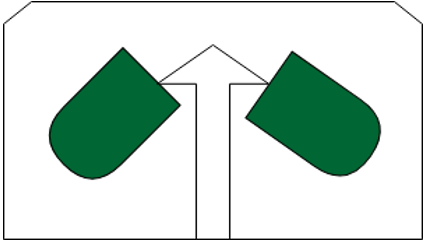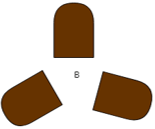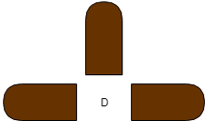This set of Biophysics Multiple Choice Questions & Answers (MCQs) focuses on “Centrifugation – Set 2”.
1. What does it mean by Rate-zonal centrifugation (Velocity gradient centrifugation)?
a) Two molecules are of the same size but different shape
b) Two molecules are of different size but the same shape
c) Two molecules have different density
d) Two molecules have the same molecular weight
View Answer
Explanation: Rate-zonal centrifugation is to differentiate between linear vs globular proteins. Sometimes, in addition, researchers use a sucrose density gradient too, to get a better result. So, the basic concept is that the molecule with a greater frictional coefficient will move slower.
2. What is the synonym of the technique Velocity gradient centrifugation _________
a) density gradient centrifugation
b) rate-zonal centrifugation
c) isopycnic centrifugation
d) moving boundary centrifugation
View Answer
Explanation: The other name of velocity gradient centrifugation is called rate-zonal centrifugation. This named as velocity gradient because we use sucrose gradient to separate molecule on the principle of rate-zonal centrifugation.
3. When Isopycnic centrifugation technique is used?
a) To separate two samples only the basis of their viscosity
b) To separate two samples only the basis of their density
c) To separate two samples only the basis of their charge
d) To separate two samples only the basis of their shape
View Answer
Explanation: This technique mostly uses cesium chloride as a gradient material. So because of this high-density gradient, the molecule gets separated only on the basis of their density. This technique has one disadvantage that this takes a very long time to complete, almost 38-50 hours.
4. Moving boundary centrifugation and zone centrifugation works on the same principle.
a) True
b) False
View Answer
Explanation: Moving boundary and zonal centrifugation are same. Zone centrifugation is called a moving boundary because the sample is separated on the basis of two layers – either it will be on the pellet or it will be on the supernatant.
5. Suppose you have only one tube of protein to be centrifuged which of the following way you will perform through centrifugation?
a) I will take the centrifuge tube and place it in one hole of the centrifuge tube holder
b) I will take another tube filled with the same amount of water and place both of them at 90-degree angle
c) I will take another tube filled with the same amount of water and place both of them at a 150-degree angle
d) I will take another tube filled with the same amount of water and place both of them at a 180-degree angle
View Answer
Explanation: The tubes must be placed in such a way so that the resultant force is 0. If it is not followed then due to the high-speed imbalanced rotation, the rotor will break into pieces.
6. Moving zone centrifugation works on what principle?
a) Same molecular density only
b) Similar molecular weight but different density
c) Same molecular density and the same shape
d) Same density but different molecular weight or different shape
View Answer
Explanation: Moving zone centrifugation is a special type of technique in which we just rotated the sample at a high speed. So, the sample at a particular rpm will be either in the supernatant or in the pallet. Through this method, the molecule, which has the same density, gets separated on the basis of molecular weight only.
7. Isopycnic centrifugation works on which of the following principle?
a) The same shape only
b) Similar molecular weight but different density
c) Same density but different molecular weight or different shape
d) Different molecular weight only
View Answer
Explanation: This method involves centrifuging a sample through a continuous gradient mixture. So after proper centrifugation, the bands are found on at that position where the density of the sample is matched with the density of the gradient.
8. You have different sets of centrifuge tube and you need to centrifuge them all. In a centrifuge machine, you different options of placing centrifuge tubes as described in the following pictures. Among these options which one is not the correct way of placing centrifuge tubes?
a)

Explanation: The centrifuge machine rotates the tubes in a very high speed, so the tube must be placed in a way that equilibrates the centrifugal forces in the system. In the d option, the resultant force of the test tubes is not zero so it is not the correct way of placement.
9. Best on the sedimentation coefficient, arrange the following cellular organelle in an increasing sedimentation coefficient (Svedberg unit):-
Ribosome, mitochondria, nucleic acid, protein, lysosomes
a) Lysosome, Ribosome, mitochondria, nucleic acid, protein
b) Ribosome, mitochondria, nucleic acid, protein, lysosome
c) Protein, nucleic acid, Ribosome, lysosome, mitochondria
d) Ribosome, mitochondria, lysosome, Nucleic acid, protein
View Answer
Explanation: Proteins have higher molecular weight compared to others so they get separated first. Then nucleic acid gets separated. The mitochondria have needs higher Svedberg to be separated. Lysosome comes after the ribosome.
10. Depending on the sensitivity of the technique in terms of separation, find the correct option.
a) The high-speed centrifuge is not more sensitive than normal centrifuge
b) Ultra-centrifuge is the most sensitive technique
c) High-speed centrifugation is more sensitive than preparative Ultra-centrifugation technique
d) High-speed centrifugation is more sensitive than analytical Ultra-centrifugation technique
View Answer
Explanation: Preparative and analytical are both highly sensitive as they require a high speed of rotation. Secondly, the first option is incorrect because high-speed centrifugation is definitely more sensitive than common centrifugation.
11. Among which of the following centrifuge machine has the highest speed of rotation.
a) Analytical Ultra-centrifuge
b) Preparative Ultra-centrifuge
c) High-speed centrifugation
d) Low-speed centrifugation
View Answer
Explanation: Analytical Ultra-centrifuge can be reached more than 600000 g centrifugal force equivalent rotation. Whereas preparative mostly works on 400000 g centrifugal force equivalent rotation. So the first option is correct as the rest of the two has low rpm.
12. Imagine a following diagram is a centrifuge machine, where the green colored parts show the orientations of the test tube rotation. Among the following options, one tells wrong information about this type of centrifugation machine. Identify that option.

a) Bacterial cell pelleting
b) Protein separation
c) Density gradient centrifugation
d) Nucleic acid separation
View Answer
Explanation: For the generation of density gradient both the rotor should be 180 degrees to each other so that a linear gradient forms. Here for the rest of the options, it does not matter the orientation of the rotor.
13. Suppose you have a mixture of protein solution which contains protein A and protein B. You performed density gradient centrifugation and got the following bands. What will you correctly infer at the time of rotation?

a) Protein A and B rotate in different rpm
b) Protein A and B rotate at same rpm but at different angular momentum
c) Protein A and B rotate at different rpm but at same angular momentum
d) Protein A and B rotate at same rpm but at same angular momentum
View Answer
Explanation: Rotation per minute or rpm for both the proteins are the same as they both are in the same test tube. But they are in a different position so they will have different angular speeds. Here protein B will have higher rpm.
14. In isodensity centrifugation what type of gradient is used?
a) CsCl gradient
b) Sucrose gradient
c) Gel gradient
d) Alcohol gradient.
View Answer
Explanation: Isodensity because initially the sample is uniformly mixed with the gradient in this type of centrifugation. This technique is also called Isopycnic centrifugation. This is the best method for separation on the basis of density.
15. If you want to purify a virus, what is the best effective method?
a) Moving boundary centrifugation
b) Differential and density gradient centrifugation
c) Isopycnic centrifugation
d) High-speed centrifugation
View Answer
Explanation: Virus isolation is a very tough procedure, so it needs a very sensitive yet gradient centrifugation. So for virus separation, the sample is ultra-centrifuged with gradient. Sometimes this procedure takes more than 10 hours to complete.
Sanfoundry Global Education & Learning Series – Biophysics.
To practice all areas of Biophysics, here is complete set of 1000+ Multiple Choice Questions and Answers.
If you find a mistake in question / option / answer, kindly take a screenshot and email to [email protected]



